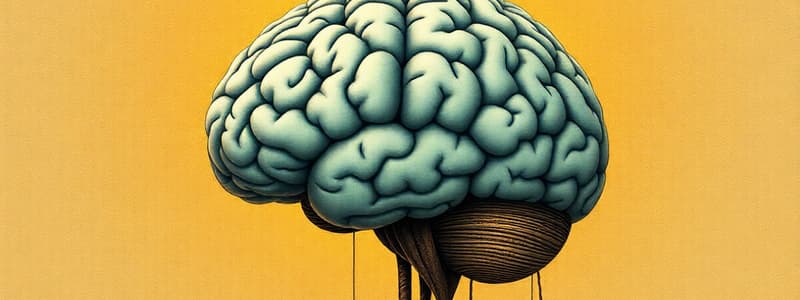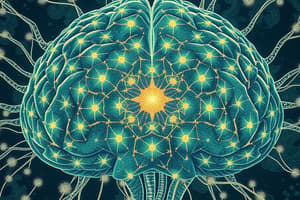Podcast
Questions and Answers
What is the consequence of disrupting the indirect pathway in primates?
What is the consequence of disrupting the indirect pathway in primates?
- It reduces excessive grooming.
- It enhances the termination of motor programs.
- It induces stereotypical behaviours. (correct)
- It strengthens the direct pathway.
Which statement best describes the role of the indirect pathway in motor control?
Which statement best describes the role of the indirect pathway in motor control?
- It directly executes motor commands.
- It increases the amount of dopamine in the system.
- It inhibits motor commands to prevent repetition. (correct)
- It selects motor commands for performance.
What is a likely effect of excess dopamine on motor behavior?
What is a likely effect of excess dopamine on motor behavior?
- Improved inhibition in the striatum.
- Increased motor program termination.
- Imbalance favoring direct pathways. (correct)
- Decreased occurrence of stereotypical behaviours.
In the context of motor behaviours, what does GABA antagonism in the GPe indicate?
In the context of motor behaviours, what does GABA antagonism in the GPe indicate?
Which behaviour is associated with stereotypy in non-human animals due to imbalance in the motor pathways?
Which behaviour is associated with stereotypy in non-human animals due to imbalance in the motor pathways?
What effect does GABA antagonist injection in the anterior GPe have on monkey behavior?
What effect does GABA antagonist injection in the anterior GPe have on monkey behavior?
What does the indirect 'No-Go' pathway primarily result in?
What does the indirect 'No-Go' pathway primarily result in?
How did GABA antagonist injection in the dorsal GPe affect the monkeys?
How did GABA antagonist injection in the dorsal GPe affect the monkeys?
Which brain regions are primarily involved in the direct 'Go' pathway?
Which brain regions are primarily involved in the direct 'Go' pathway?
During what behavior do monkeys primarily spend their time before injection?
During what behavior do monkeys primarily spend their time before injection?
What role does the globus pallidus external segment (GPe) play in the normal functioning of the indirect pathway?
What role does the globus pallidus external segment (GPe) play in the normal functioning of the indirect pathway?
Which neurotransmitter is primarily associated with excitatory connections in the indirect pathway?
Which neurotransmitter is primarily associated with excitatory connections in the indirect pathway?
What is the effect of injecting a GABA antagonist in the GPe on motor commands?
What is the effect of injecting a GABA antagonist in the GPe on motor commands?
Which structure is responsible for strong inhibition of the thalamus in the indirect pathway?
Which structure is responsible for strong inhibition of the thalamus in the indirect pathway?
What behavior was observed in monkeys when the indirect pathway was disrupted?
What behavior was observed in monkeys when the indirect pathway was disrupted?
What happens to the thalamus when the indirect pathway functions normally?
What happens to the thalamus when the indirect pathway functions normally?
Which component is not part of the indirect pathway as described?
Which component is not part of the indirect pathway as described?
Which type of connection does GABA represent in the context of the indirect pathway?
Which type of connection does GABA represent in the context of the indirect pathway?
What effect does interference with the anterior GPe have on behavior?
What effect does interference with the anterior GPe have on behavior?
How does the posterior GPe affect behavior in monkeys?
How does the posterior GPe affect behavior in monkeys?
What behavioral trait was observed more in certain mice compared to others?
What behavioral trait was observed more in certain mice compared to others?
What is suggested to cause higher stereotypical behavior in some mice?
What is suggested to cause higher stereotypical behavior in some mice?
What substance's concentration reflects activity in the direct pathway of the striatum?
What substance's concentration reflects activity in the direct pathway of the striatum?
What role do the basal ganglia play according to the content provided?
What role do the basal ganglia play according to the content provided?
What type of behaviors were studied in animals to understand individual differences?
What type of behaviors were studied in animals to understand individual differences?
What has been linked to stereotypical behaviors in animal studies?
What has been linked to stereotypical behaviors in animal studies?
What is correlated with the increase in tic severity in Tourette syndrome?
What is correlated with the increase in tic severity in Tourette syndrome?
How do antipsychotics affect OCD symptoms?
How do antipsychotics affect OCD symptoms?
What learning tendency is associated with individuals having Tourette syndrome?
What learning tendency is associated with individuals having Tourette syndrome?
What can contribute to the maintenance of compulsive behavior in OCD?
What can contribute to the maintenance of compulsive behavior in OCD?
What effect does excessive dopamine release have on action selection?
What effect does excessive dopamine release have on action selection?
How does anxiety influence behavior regarding learned habits?
How does anxiety influence behavior regarding learned habits?
What is a direct consequence of the imbalance created by excessive dopamine release?
What is a direct consequence of the imbalance created by excessive dopamine release?
What aspect of punishment learning is noted in individuals with OCD?
What aspect of punishment learning is noted in individuals with OCD?
Flashcards are hidden until you start studying
Study Notes
Thalamus & The Basal Ganglia
- The thalamus plays a crucial role in relaying sensory information to the cortex
- The basal ganglia, specifically the direct and indirect pathways, are involved in selecting and inhibiting motor commands.
Direct vs. Indirect Pathways
- The direct pathway promotes movement by exciting the thalamus, leading to the selection of a motor command.
- The indirect pathway inhibits movement by suppressing the thalamus. This is often referred to as the "No-Go" pathway.
- An imbalance, with the direct pathway being more active than the indirect pathway, can lead to a "Go" bias, potentially causing repetitive behaviors.
Stereotypical Behavior
- Animals with a direct > indirect imbalance can exhibit stereotypical behaviors, such as excessive grooming or repetitive movements like lever pressing.
- Disrupting the indirect pathway, by injecting a GABA antagonist into the GPe, can induce stereotypical behaviors in monkeys, highlighting the role of the indirect pathway in inhibiting unwanted motor programs.
Individual Differences
- Naturally occurring variations in animals, including differences in stereotypic behavior, suggest a role for the basal ganglia in individual differences.
- Mice with a high incidence of stereotypic jumping show lower activity in the indirect pathway.
- This imbalance is further evidenced by lower enkephalin (indirect pathway) and higher dynorphin (direct pathway) concentrations in their striatum.
Humans & Dopaminergic Hyperactivity
- Individuals with OCD and Tourette syndrome display heightened dopaminergic activity in the striatum, suggesting a direct > indirect imbalance.
- This imbalance may explain the increased tic severity in Tourette syndrome after amphetamine administration, a dopamine stimulant.
- Antipsychotic medications, which block dopamine receptors, can alleviate OCD symptoms.
Decision-Making vs Learning
- An excessive dopamine release leading to a direct > indirect imbalance can influence both action selection and learning.
- In action selection, it becomes easier to select and harder to inhibit familiar habits, contributing to the persistence of repetitive behaviors.
- In learning, this imbalance can lead to a stronger learning from rewards (potentially reinforcing the habit) and weaker learning from punishment, which can contribute to the maintenance of unwanted behaviors.
Anxiety
- Elevated anxiety can exacerbate habit-like behaviors by reducing goal-directed behavior and making it easier to select habitual actions.
- While anxiety may not directly influence learning, it can impact how habits are expressed and executed.
Summary
- Imbalances in the basal ganglia, specifically the direct and indirect pathways, are implicated in repetitive behaviors and possibly disorders like OCD and Tourette syndrome.
- This imbalance can influence both action selection and learning, and factors like anxiety can further amplify these effects.
Studying That Suits You
Use AI to generate personalized quizzes and flashcards to suit your learning preferences.




